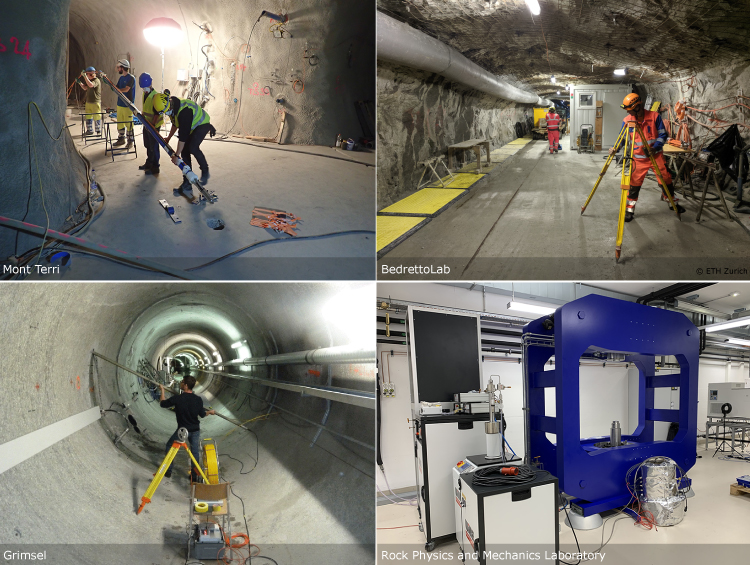2021-11-04
Research in Swiss rock laboratories
Rock laboratories located deep underground, several hundred metres below the earth's surface, are key research facilities for geoscientists around the world, allowing them to observe geological and physical processes at close range under controlled and reproducible conditions and in great detail. The Swiss Seismological Service (SED) at ETH Zurich also makes use of these laboratories for many of its scientific activities. To mark 25 years of research at the Mont Terri rock laboratory in the canton of Jura, we want to shine the spotlight on this work.
Read more...The SED, as well as other research groups within the ETH Zurich Department of Earth Sciences, is a long-standing partner of the Mont Terri rock laboratory, which has grown from a basic research facility in a side tunnel of the motorway tunnel between Saint-Ursanne and Courgenay into an internationally recognised institution. While research into the storage of radioactive waste was initially the laboratory's primary focus, in recent years work at the facility has increasingly been centred around the underground storage of CO2. The SED has also been active in this field for several years as part of ELEGANCY, a research project funded by the Swiss Federal Office of Energy (SFOE) and the EU intended to investigate whether CO2 extracted from industrial production (from waste incineration plants or the atmosphere, for instance) can be captured and safely stored deep underground permanently, whether in Switzerland or elsewhere. Several such carbon capture and storage (CCS) projects have already been rolled out around the world. One of the challenges here lies in ensuring that CO2 does not slowly migrate to the earth's surface through fault zones (fracture zones deep underground) in the caprock and thus re-enter the atmosphere. To prevent this from occurring, we need a better understanding of the physical and chemical processes that influence whether and how CO2 could escape through fault zones. We also need to look into whether the injected CO2 could trigger microquakes.
To this end, researchers from the SED and partner institutions injected several litres of CO2-enriched saltwater into a fault zone in the Opalinus Clay over a period of several months at varying pressures, using geophysical and geochemical measurement sensors to monitor exactly what was happening in the rock. In principle, Opalinus Clay is an ideal caprock for a CO2 storage facility because it is extremely impermeable to water. Until now, however, it was unclear whether CO2 could migrate through fault zones in the clay. Initial results of the research conducted at Mont Terri show that the CO2 injected near the natural fault zone rises as expected. However, rather than just taking the path of least resistance, i.e. along the fault, it also spreads in the surrounding area in a complex pattern, mixing with the CO2 already present in the fault zone. As such, though CO2 does move towards the earth's surface, it does so very slowly. In addition, the clay swells as soon as it comes into contact with the CO2-saltwater mixture. This causes any cracks to close again, so there are no ways for CO2 to rise. We can therefore assume that Opalinus Clay is a very efficient caprock and that no CO2 would escape from the reservoir for thousands of years. In the medium term, CO2 becomes part of the rock or is mineralised and is then permanently bound. The research findings are currently being prepared for scientific publication. Mont Terri's research thus contributes to achieving the UN climate goals, in which negative emissions using CCS play an important role.
ETH Zurich also operates a rock laboratory in a tunnel deep underground, though this lab focuses on a slightly different field. The BedrettoLab is a research facility located about 1.5 kilometres below the earth's surface and in the middle of a 5.2-kilometre-long tunnel connecting Ticino with the Furka railway tunnel. The lab is home to a number of teams of scientists conducting experimental research, more specifically with a view to developing new methods for creating an efficient heat exchanger deep underground without triggering major perceptible or damaging earthquakes. The researchers also want to intentionally trigger very weak earthquakes with magnitudes of 0 to 1, which cannot be felt by humans, so that they can observe the approximately 10- to 30-metre-long fracture process from a few metres away. These experiments produce new scientific findings for geothermal energy and earthquake physics, as well as new techniques and sensors that can be used in this field. The SED is one of the BedrettoLab's key research partners and is responsible for the seismic monitoring of all activities.
Even before the BedrettoLab opened its doors, the SED was collecting initial, vital data on the connection between geothermal energy and induced earthquakes at another rock laboratory in Switzerland, the Grimsel Test Site. Though on a somewhat smaller scale than in the Bedretto Valley, researchers investigated the physics of induced earthquakes, i.e. quakes stimulated by deep geothermal power projects, for example. The research in rock laboratories is supplemented by small-scale experiments with rock samples performed in the Rock Physics and Mechanics Laboratory at ETH Zurich, where researchers can control the environment better than directly in the rock. In order to advance research, research laboratories – whether in the rock deep below the earth's surface or in ETH's buildings – are key to enabling the scientific community to get to grips with the complex processes under way in the bowels of the earth.
